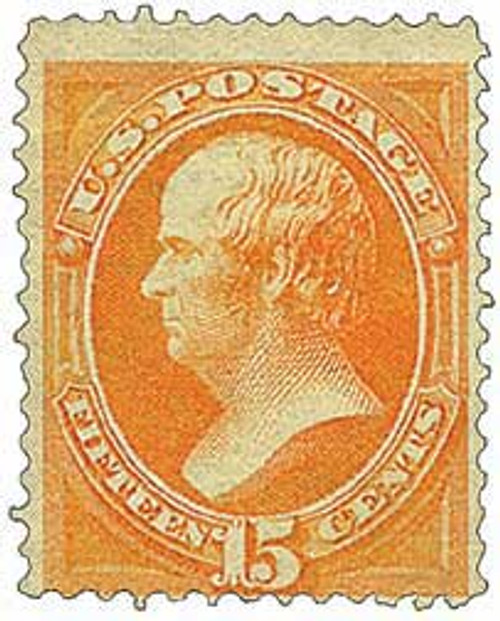
# 152 - 1870-71 15c Webster, bright orange
1870-71 15¢ Webster
National Bank Note Printing
Earliest Known Use: June 24, 1870
Quantity issued: 5,033,300 (estimate)
Printed by: National Bank Note Company
Method: Flat plate
Watermark: None
Perforation: 12
Color: Bright orange
Webster’s Stamp Proposal

On June 10, 1840, Senator Daniel Webster submitted a resolution to the US Congress recommending that the US issue stamps.
Webster’s proposal had been inspired by the issue of the world’s first postage stamp, the Penny Black, in Great Britain a month earlier on May 1. All eyes were on Great Britain to see how their experiment would turn out.

In America, the US Post Office was struggling with increasing annual deficits. This was in large part due to the complicated and pricey system of postal rates. Additionally, many letters were sent with the expectation that the addressee would pay for the postage, but they often refused. This meant the Post Office carried these letters, sometimes long distances, and never received any payment for them.

Webster was convinced that the US should follow Great Britain’s example and immediately began formulating a resolution to propose a similar system in America. To help support his case, Webster commissioned William J. Stone to reproduce engravings of the Penny Black and the Mulready envelope to accompany his resolution. In later years, many would remark that Stone’s engraving was superior to the Mulready envelopes produced in Great Britain. (You can view Stone’s engraving here.)
On June 10, 1840, Webster addressed the 26th Session of Congress with his resolution, sharing his reproductions and arguing in favor of new rates and stamps. Among his points were “That the rates of postage charged on letters transmitted by the mails of the United States ought to be reduced.” And he went on to say “That it is expedient to inquire into the utility of so altering the present regulations of the Post Office Department as to connect the use of stamps, or stamped covers, with a large reduction in the rates of postage.”

Despite his convincing and impassioned presentation, Congress took no action. At the time, many feared that reducing postage rates would only increase the Post Office’s deficit. It would take five years for them to pass the Postal Act of 1845, which set uniform nationwide postal rates. And it would be another two years before they issued America’s first postage stamps in July 1847.
1870-71 15¢ Webster
National Bank Note Printing
Earliest Known Use: June 24, 1870
Quantity issued: 5,033,300 (estimate)
Printed by: National Bank Note Company
Method: Flat plate
Watermark: None
Perforation: 12
Color: Bright orange
Webster’s Stamp Proposal

On June 10, 1840, Senator Daniel Webster submitted a resolution to the US Congress recommending that the US issue stamps.
Webster’s proposal had been inspired by the issue of the world’s first postage stamp, the Penny Black, in Great Britain a month earlier on May 1. All eyes were on Great Britain to see how their experiment would turn out.

In America, the US Post Office was struggling with increasing annual deficits. This was in large part due to the complicated and pricey system of postal rates. Additionally, many letters were sent with the expectation that the addressee would pay for the postage, but they often refused. This meant the Post Office carried these letters, sometimes long distances, and never received any payment for them.

Webster was convinced that the US should follow Great Britain’s example and immediately began formulating a resolution to propose a similar system in America. To help support his case, Webster commissioned William J. Stone to reproduce engravings of the Penny Black and the Mulready envelope to accompany his resolution. In later years, many would remark that Stone’s engraving was superior to the Mulready envelopes produced in Great Britain. (You can view Stone’s engraving here.)
On June 10, 1840, Webster addressed the 26th Session of Congress with his resolution, sharing his reproductions and arguing in favor of new rates and stamps. Among his points were “That the rates of postage charged on letters transmitted by the mails of the United States ought to be reduced.” And he went on to say “That it is expedient to inquire into the utility of so altering the present regulations of the Post Office Department as to connect the use of stamps, or stamped covers, with a large reduction in the rates of postage.”

Despite his convincing and impassioned presentation, Congress took no action. At the time, many feared that reducing postage rates would only increase the Post Office’s deficit. It would take five years for them to pass the Postal Act of 1845, which set uniform nationwide postal rates. And it would be another two years before they issued America’s first postage stamps in July 1847.

















